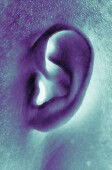
THURSDAY, May 13 (HealthDay News) — Researchers have made a big leap in deafness research by creating mouse cells in the laboratory that are similar to inner-ear cells which play a crucial role in the ability to hear.
The cells in the inner ear have hair-like projections, called stereocilia. When sound vibrations reach the stereocilia, the vibrations are converted into a signal that can be interpreted in the brain as sound. But when these hair cells are lost or damaged, they cannot regenerate, and hearing loss occurs.
The scientists hope to generate hair cells in the millions, which could lead to significant advances on the road to curing deafness for many in the future, according to their report in the May 14 issue of the journal Cell.
“This gives us real hope that there might be some kind of therapy for regenerating hair cells,” David Corey, professor of neurobiology at Harvard University, said in a news release from the Stanford University School of Medicine.
“It could take a decade or more, but it’s a possibility,” said Corey, who was not involved in the study.
The researchers created the cells from mice by using embryonic stem cells (a type of embryo cell that has the remarkable ability to change into other types of cells) and mouse fibroblasts (cells found in connective tissue). “We knew it was really working when we saw them in the electron microscope. They really looked like they were more or less taken out of the ear,” Stefan Heller, a Stanford professor of otolaryngology whose laboratory led the research, said in the news release.
“Our study offers a protocol to generate millions of functional hair cells from a renewable source,” Heller said. “We can now generate these cells and don’t have to go through dozens of mice for a single experiment. This allows us to do molecular studies with much higher efficiency.”
An estimated one-third of adults over the age of 65 have hearing loss because some hair cells have been destroyed.
More information
For more on hearing loss and deafness, try the U.S. National Library of Medicine.

